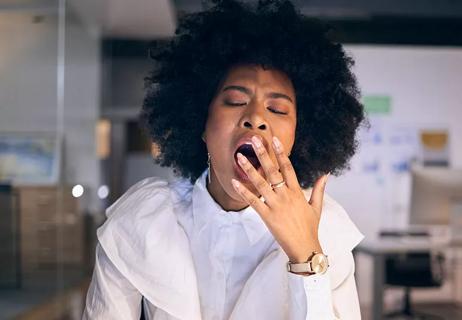This style of breathwork can invigorate you and help you focus

How often do you stop to think about your breath? Probably not very often, if you’re like most people. In, out, in, out … as long as your body is doing what it’s supposed to do, you’re likely not giving much thought to this particular bodily function.
Advertisement
Cleveland Clinic is a non-profit academic medical center. Advertising on our site helps support our mission. We do not endorse non-Cleveland Clinic products or services. Policy
But maybe it’s time to start. Techniques like alternate nostril breathing can help you relieve stress, improve concentration and even become a better breather overall.
Integrative medicine specialist Melissa Young, MD, explains why this yogic breathing technique is so good for you and walks you through exactly how to do it for the best benefits.
Known in Sanskrit as Nadī Shodhana, alternate nostril breathing is also sometimes called channel-cleaning breath — and actually, those two names tell you a lot about what it can do.
Nadī refers to the energy that circulates throughout your body, while Shodhana refers to purifying or cleansing. Nadī Shodhana, then, is said to help clear your energy channels and bring about inner balance.
“You do it by isolating each nostril, breathing in through only one of them at a time and then exhaling through the other,” Dr. Young says. Before sharing a step-by-step guide to doing it yourself, though, she explains some of the health benefits.
In general, breathwork can positively affect your mental and physical health, and alternate nostril breathing has some particular benefits. Here’s what this technique can do for you and why it’s worth practicing.
Advertisement
Your body can go into “fight or flight” mode even when it’s not in imminent danger. Blame it on your sympathetic nervous system, the part of your body responsible for this function, which also activates when you’re under stress.
But you can counteract it by activating your parasympathetic nervous system, which plays a huge role in helping you feel calm and relaxed. Breathing techniques like alternate nostril breathing are a great way to do so.
“When the body is in that relaxed state, it can actually start to heal and repair,” Dr. Young says. “Calming our nervous system is so important for our health because we know that stress plays a role in a number of medical conditions.”
One study found that after practicing alternate nostril breathing for 12 weeks, male participants reported lower levels of stress. Another study found that this technique helped lower stress in pregnant survivors of intimate partner violence.
Relaxing your parasympathetic nervous system doesn’t necessarily mean becoming so chill that you’re a limp noodle. In fact, this particular type of breathwork can leave you feeling surprisingly invigorated.
“Like all breathing techniques, alternate nostril breathing is very calming,” Dr. Young says, “but you may also find that it leads you to clearer, brighter concentration and higher levels of energy.”
One study found that alternate nostril breathing decreases blood pressure while increasing alertness. (For that reason, this breathing technique isn’t your best choice before bed. To lull yourself to sleep, try 4-7-8 breathing instead.)
Practicing something makes you better at it — and breathing is no different. “Most of us don’t actually breathe as well as we should,” Dr. Young says.
But alternate nostril breathing can help. It’s been shown to improve cardiorespiratory function, or the way your heart and lungs work together to make sure you’re getting enough oxygen. It even helps competitive swimmers maintain respiratory endurance while they’re in the water.
To start, Dr. Young says, “Take a seat, whether in a chair or the floor. It doesn’t matter which you choose, so long as you’re sitting up straight and tall.”
The idea of alternate nostril breathing is to isolate each nostril, breathing in through one and exhaling through the other. Here’s how to practice this breathing technique:
Advertisement
In summary, that’s in through your left, out through your right; in through your right, out through your left. Whenever a nostril isn’t in use for an inhale or an exhale, it should be held shut with your finger or thumb.
Repeat the process for as long as you like. Dr. Young recommends five minutes at a time.
Try to do five minutes of alternate nostril breathing per day to reap the most benefits. But be gentle with yourself if you can’t get the hang of it right away.
“It’s not always easy to remember or act out the sequence of this particular breathing technique,” Dr. Young concedes. “But if you continue to practice it, you will see positive impacts on your health and well-being.”
To hear more on this topic, listen to the Health Essentials Podcast episode, “Breathwork for Beginners.” New episodes of the Health Essentials Podcast publish every Wednesday.
Advertisement
Learn more about our editorial process.
Advertisement

Changing how you breathe, gargling water and distracting yourself are all common ways to stop your diaphragm from spasming

Simple at-home solutions, like doing pursed lip breathing and drinking a warm beverage, can often bring immediate relief

Mouth taping may seem promising, but it can actually cause more harm than good, especially if you snore or have sleep apnea

When something like food or drink goes down your windpipe rather than your esophagus, it can cause coughing and sometimes choking

Getting vaccinated in October can help protect you against severe illness between November and March

Breathing through your nose is far better for you, but depending on your anatomy, that may not always be possible

One theory is brain temperature regulation, and yes, a ‘contagious yawn’ is a real thing

Dry drowning is an airway closure from choking on water without getting fluid in your lungs

Babies can get congested easily, but you can calm their cough by keeping them hydrated, using nasal drops and running a humidifier

Weight loss may cause loose, sagging skin and muscle loss to your rear

Several conditions, like vitiligo and fungal infection, can cause a loss of pigmentation, leading to white spots or patches on your skin